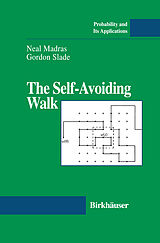The Self-Avoiding Walk
Einband:
Kartonierter Einband
EAN:
9780817638917
Untertitel:
Probability and Its Applications
Genre:
Mathematik
Autor:
Gordon Slade, Neal Madras
Herausgeber:
Birkhäuser Boston
Auflage:
1996
Anzahl Seiten:
446
Erscheinungsdatum:
28.08.1996
ISBN:
0817638911
A self-avoiding walk is a path on a lattice that does not visit the same site more than once. In spite of this simple definition, many of the most basic questions about this model are difficult to resolve in a mathematically rigorous fashion. In particular, we do not know much about how far an n step self-avoiding walk typically travels from its starting point, or even how many such walks there are. These and other important questions about the self-avoiding walk remain unsolved in the rigorous mathematical sense, although the physics and chemistry communities have reached consensus on the answers by a variety of nonrigorous methods, including computer simulations. But there has been progress among mathematicians as well, much of it in the last decade, and the primary goal of this book is to give an account of the current state of the art as far as rigorous results are concerned. A second goal of this book is to discuss some of the applications of the self-avoiding walk in physics and chemistry, and to describe some of the nonrigorous methods used in those fields. The model originated in chem istry several decades ago as a model for long-chain polymer molecules. Since then it has become an important model in statistical physics, as it exhibits critical behaviour analogous to that occurring in the Ising model and related systems such as percolation.
Klappentext
The self-avoiding walk is a mathematical model with important applications in statistical mechanics and polymer science. This text provides a unified account of the rigorous results for the self-avoiding walk, focusing on its critical behaviour. Topics discussed include: the lace explosion and its application to the self-avoiding walk in more than four dimensions where most issues are now resolved; an introduction to the nonrigorous scaling theory; classical work of Hammersley and others; an exposition of Kesten's pattern theorem and its consequences; a discussion of the decay of the two-point function and its relation to probabilistic renewal theory; and the role of the self-avoiding walk in physical and chemical applications.
Zusammenfassung
"An excellent introduction for graduate students and professional probabilists... The best place to find a self-contained exposition of lace expansion." -Bulletin of the AMS "As a carefully written and carefully referenced exposition of an intriguing topic...this monograph is strongly recommended." -Monatshefte Mathematik "In this book, the reader will find basically everything there is to know about rigorous mathematical results on self-avoiding walks... It is nicely written and should be read by mathematical physicists and probabilists interested in applications to natural sciences." -Belgian Mathematical Society "This is the first book on self-avoiding random walk and a very good one." -SIAM Review "An excellent book that should be on the shelf of anyone doing work at the intersection of probability and critical phenomena... The best results about the SAW can still be found here." --Annals of Probability
Inhalt
1 Introduction.- 1.1 The basic questions.- 1.2 The connective constant.- 1.3 Generating functions.- 1.4 Critical exponents.- 1.5 The bubble condition.- 1.6 Notes.- 2 Scaling, polymers and spins.- 2.1 Scaling theory.- 2.2 Polymers.- 2.3 The N ? 0 limit.- 2.4 Notes.- 3 Some combinatorial bounds.- 3.1 The Hammersley-Welsh method.- 3.2 Self-avoiding polygons.- 3.3 Kesten's bound on cN.- 3.4 Notes.- 4 Decay of the two-point function.- 4.1 Properties of the mass.- 4.2 Bridges and renewal theory.- 4.3 Separation of the masses.- 4.4 Ornstein-Zernike decay of GZ(0, x).- 4.5 Notes.- 5 The lace expansion.- 5.1 Inclusion-exclusion.- 5.2 Algebraic derivation of the lace expansion.- 5.3 Example: the memory-two walk.- 5.4 Bounds on the lace expansion.- 5.5 Other models.- 5.6 Notes.- 6 Above four dimensions.- 6.1 Overview of the results.- 6.2 Convergence of the lace expansion.- 6.3 Fractional derivatives.- 6.4 cn and the mean-square displacement.- 6.5 Correlation length and infrared bound.- 6.6 Convergence to Brownian motion.- 6.7 The infinite self-avoiding walk.- 6.8 The bound on cn(0,x).- 6.9 Notes.- 7 Pattern theorems.- 7.1 Patterns.- 7.2 Kesten's Pattern Theorem.- 7.3 The main ratio limit theorem.- 7.4 End patterns.- 7.5 Notes.- 8 Polygons, slabs, bridges and knots.- 8.1 Bounds for the critical exponent ?sing.- 8.2 Walks with geometrical constraints.- 8.3 The infinite bridge.- 8.4 Knots in self-avoiding polygons.- 8.5 Notes.- 9 Analysis of Monte Carlo methods.- 9.1 Fundamentals and basic examples.- 9.2 Statistical considerations.- 9.3 Static methods.- 9.4 Length-conserving dynamic methods.- 9.5 Variable-length dynamic methods.- 9.6 Fixed-endpoint methods.- 9.7 Proofs.- 9.8 Notes.- 10 Related topics.- 10.1 Weak self-avoidance and the Edwards model.- 10.2 Loop-erased randomwalk.- 10.3 Intersections of random walks.- 10.4 The myopic or true self-avoiding walk.- A Random walk.- B Proof of the renewal theorem.- C Tables of exact enumerations.- Notation.

Leider konnten wir für diesen Artikel keine Preise ermitteln ...
billigbuch.ch sucht jetzt für Sie die besten Angebote ...
Die aktuellen Verkaufspreise von 6 Onlineshops werden in Realtime abgefragt.
Sie können das gewünschte Produkt anschliessend direkt beim Anbieter Ihrer Wahl bestellen.
Loading...
Die aktuellen Verkaufspreise von 6 Onlineshops werden in Realtime abgefragt.
Sie können das gewünschte Produkt anschliessend direkt beim Anbieter Ihrer Wahl bestellen.
| # | Onlineshop | Preis CHF | Versand CHF | Total CHF | ||
|---|---|---|---|---|---|---|
| 1 | Seller | 0.00 | 0.00 | 0.00 |
